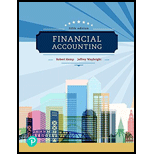
Financial Accounting
5th Edition
ISBN: 9780134728643
Author: Robert Kemp; Jeffrey Waybright
Publisher: Pearson Education (US)
expand_more
expand_more
format_list_bulleted
Textbook Question
Chapter 12, Problem 33AP
Financial statement data of Helgeson Enterprises. Inc., include the following items:
| Cash.......................................................... | $ 24,300 |
| Short-Term investments.......................................................... | 28,100 |
| 90,600 | |
| Inventory...................................................«...... | 116,800 |
| Prepaid Expenses..............................................................................-................ | 11, 330 |
| Total Assets......................................................................................................... | 662,700 |
| Short-Term Notes payable................................................................................. | 50,000 |
| Accounts Payable | 78,300 |
| Accrued Liabilities.............................................................................................. | 32,500 |
| Long-Term Notes Payable........................................................................... | 150,000 |
| Other Long Term Liabilities................................................................. | 41,200 |
| Net Income......................................................................................................... | 82,900 |
| Number of Common Shares Outstanding............................................................ | 35,000 |
Requirements
- 1. Compute Helgeton Enterprise current ratio, debt ratio, and earnings per share. Assume that the company has no
preferred stock outstanding. Round all ratios to two decimal places. - 2. Compute the same three ratios after evaluating the effect of each of the following independent transactions
- a. Purchased merchandise of $35,600 on account, debiting Inventory.
- b. Issued 6,000 shares of common stock, receiving cash of $75,000. Use total shares outstanding at year’s end instead of average shares outstanding.
- c. Borrowed $45,000 on a long-term note payable.
- d. Received cash on account, $12,000
Quick solution
1. Current ratio = 1.69, Debt ratio = 53.12percent, EPS = $2.37
2a. Current ratio = 1.56, Debt ratio = 55.51percent, EPS = $2.37
2b. Current ratio = 2.15, Debt ratio = 47.72percent, EPS = $2.02
2c. Current ratio = 1.97, Debt ratio = 56.10percent, EPS = $2.37
2d. Current ratio = 1.69, Debt ratio = 53.12percent, EPS = $2.37
Expert Solution & Answer
Want to see the full answer?
Check out a sample textbook solution
Students have asked these similar questions
What is the amount of current liabilities?
Financial Accounting MCQ
Answer below Question
Chapter 12 Solutions
Financial Accounting
Ch. 12 - Prob. 1DQCh. 12 - Which amount is the base amount for vertical...Ch. 12 - Prob. 3DQCh. 12 - Prob. 4DQCh. 12 - Prob. 5DQCh. 12 - Prob. 6DQCh. 12 - Prob. 7DQCh. 12 - How would you expect a recession to affect asset...Ch. 12 - Prob. 9DQCh. 12 - Prob. 10DQ
Ch. 12 - Prob. 1SCCh. 12 - Prob. 2SCCh. 12 - Prob. 3SCCh. 12 - Prob. 4SCCh. 12 - Prob. 5SCCh. 12 - Prob. 6SCCh. 12 - Prob. 7SCCh. 12 - Prob. 8SCCh. 12 - Prob. 9SCCh. 12 - Prob. 10SCCh. 12 - Prob. 11SCCh. 12 - Prob. 12SCCh. 12 - Prob. 1SECh. 12 - Prob. 2SECh. 12 - Prob. 3SECh. 12 - Prob. 4SECh. 12 - Prob. 5SECh. 12 - Prob. 6SECh. 12 - Prob. 7SECh. 12 - Prob. 8SECh. 12 - Prob. 9SECh. 12 - Prob. 10SECh. 12 - Horizontal analysis(Learning Objective 2)15-20 min...Ch. 12 - Prob. 12AECh. 12 - Horizontal analysis(Learning Objective 2)15-20...Ch. 12 - Prob. 14AECh. 12 - Prob. 15AECh. 12 - Prob. 16AECh. 12 - Prob. 17AECh. 12 - Horizontal analysis(Learning Objective 2)15-20...Ch. 12 - Prob. 26BECh. 12 - Prob. 27BECh. 12 - Prob. 28BECh. 12 - Prob. 29BECh. 12 - Prob. 30BECh. 12 - Trend percentages and return on assets (Learning...Ch. 12 - Common-size financial statements and profitability...Ch. 12 - Current ratio, debt ratio, EPS (Learning Objective...Ch. 12 - Calculating various ratios for analysis (Learning...Ch. 12 - Prob. 35APCh. 12 - Prob. 36APCh. 12 - Trend percentages and return on assets (Learning...Ch. 12 - Common-size financial statements and profitability...Ch. 12 - Prob. 39BPCh. 12 - Calculating various ratios for analysis(Learning...Ch. 12 - Calculating various ratios for analysis (Learning...Ch. 12 - Prob. 42BPCh. 12 - Prob. 1CECh. 12 - Prob. 1CPCh. 12 - Prob. 1EIACh. 12 - Prob. 2EIACh. 12 - Prob. 1FACh. 12 - Industry Analysis Purpose: To help you understand...Ch. 12 - Prob. 1SBACh. 12 - Prob. 1WC
Knowledge Booster
Learn more about
Need a deep-dive on the concept behind this application? Look no further. Learn more about this topic, accounting and related others by exploring similar questions and additional content below.Similar questions
- ??!!arrow_forwardStep by step answerarrow_forwardWhy does stakeholder diversity influence disclosure choices? [Financial Accounting MCQ] (1) Diversity creates problems (2) Standard reports satisfy everyone (3) Users want identical information (4) Different information needs require varied reporting approachesarrow_forward
- General Accountingarrow_forwardQuestion: - How does resource attribution mapping enhance cost allocation? 1. Attribution wastes effort 2. Equal splitting works better 3. Usage patterns determine proper distribution methods 4. Simple rules suffice always help with thisarrow_forwardWhat differentiates process-based validation from outcome testing? (A) Systematic review steps assess control effectiveness (B) Final results alone matter (C) Process review wastes time (D) Outcomes tell complete storyarrow_forward
- Provide Right answerarrow_forwardLarkspur Manufacturing Company observed that, during its busiest month of 2022, maintenance costs totaled $18,500, resulting from the production of 40,000 units. During its slowest month, $13,000 in maintenance costs were incurred, resulting from the production of 25,000 units. Use the high-low method to estimate the maintenance cost that the company will incur if it produces 30,000 units. (Calculation in 2 decimal)arrow_forwardQuestion: - How does resource attribution mapping enhance cost allocation? 1. Attribution wastes effort 2. Equal splitting works better 3. Usage patterns determine proper distribution methods 4. Simple rules suffice alwaysarrow_forward
arrow_back_ios
SEE MORE QUESTIONS
arrow_forward_ios
Recommended textbooks for you
 Cornerstones of Financial AccountingAccountingISBN:9781337690881Author:Jay Rich, Jeff JonesPublisher:Cengage Learning
Cornerstones of Financial AccountingAccountingISBN:9781337690881Author:Jay Rich, Jeff JonesPublisher:Cengage Learning Survey of Accounting (Accounting I)AccountingISBN:9781305961883Author:Carl WarrenPublisher:Cengage Learning
Survey of Accounting (Accounting I)AccountingISBN:9781305961883Author:Carl WarrenPublisher:Cengage Learning College Accounting, Chapters 1-27AccountingISBN:9781337794756Author:HEINTZ, James A.Publisher:Cengage Learning,
College Accounting, Chapters 1-27AccountingISBN:9781337794756Author:HEINTZ, James A.Publisher:Cengage Learning,

Cornerstones of Financial Accounting
Accounting
ISBN:9781337690881
Author:Jay Rich, Jeff Jones
Publisher:Cengage Learning

Survey of Accounting (Accounting I)
Accounting
ISBN:9781305961883
Author:Carl Warren
Publisher:Cengage Learning

College Accounting, Chapters 1-27
Accounting
ISBN:9781337794756
Author:HEINTZ, James A.
Publisher:Cengage Learning,
Consolidated financial statements; Author: The Finance Storyteller;https://www.youtube.com/watch?v=DTFD912ZJQg;License: Standard Youtube License